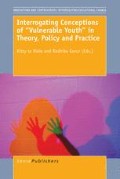Abstract
In recent years, policy makers and researchers have focused on young people who are not in education, employment or training (NEET). In 2011, approximately 1 in 10 young Australians aged 15-24 fell into this category (Muir, 2012). Whilst this figure was considerably lower than the 2011 OECD average of 16.4 per cent (OECD, 2012), the economic engagement trends of young Australians are concerning.
Access this chapter
Tax calculation will be finalised at checkout
Purchases are for personal use only
Preview
Unable to display preview. Download preview PDF.
References
Arnold, C., & Baker, T. (2013). Becoming NEET: Risks, rewards and realities.
Belfield, C., Levin, H., & Rosen, R. (2012). The economic value of opportunity youth. Corporation for National and Community Service and the White House Council for Community Solutions.
Benjet, C., Hernandez-Montoya, D., Borges, G., Mendez, E., Medina-Mora, M. E., & Aguilar-Gaxiola, S. (2012). Youth who neither study nor work: Mental health, educaiton and employment. Sauld Publica De Mexico, 54(4), 410-417.
Britton, J., Gregg, P., Macmillan, L., & Mitchell, S. (2011). The early bird … preventing young people from becoming a NEET statistic. University of Bristol.
Brotherhood of St. Laurence. (2014). On the treadmill: Young and long-term unemployed in Australia. Melbourne: Brotherhood of St. Laurence.
Bynner, J., & Parsons, S. (2002). Social exclusion and the transition from school to work: the case of young people not in education, employment or training. Journal of Vocational Behaviour, 60, 289-309.
Cass, B., Smyth, C., Hill, T., Blaxland, M., & Hamilton, M. (2009). Young carers in Australia: Understanding the advantages and disadvantages of their care giving. Canberra: Department of Families, Housing, Community Services and Indigenous Affairs.
Circelli, Michelle, & Oliver, Damian. (2012). Youth transitions: What the research tells us Canberra: National Centre for Vocational Education Research.
Cuervo, H., & Wyn, J. (2011). Rethinking youth transitions in Australia: A historical and multidimensional approach.
European Foundation for the Improvement of Living and Working Conditions. (2010). NEETs: Young people not in employment, education or training: Characteristics, costs and policy responses in Europe. Dublin: European Foundation for the Improvement of Living and Working Conditions.
Finlay, I., Sheridan, M., McKay, J., & Nudzor, H. (2010). Young people on the margins: In need of more choices and more chances. British Educational Research Journal, 36, 851-867.
Jobs Australia. (2014). Jobs Australia policy on youth transitions.
Lammas, N. (2013). Beyond earn or learn. Youth Studies Australia, 32(1), 3-4.
Muir, K. (2012). Australian young people: Where from, where to and what this might mean for mentoring. Paper presented at the Australian Youth Mentoring Conference, Gold Coast.
OECD. (2012). OECD employment outlook 2012. Paris.
Robinson, L., & Lamb, S. (2012). How young people are faring 2012. Melbourne: The Foundation for Young Australians.
Simmons, R., Russell, L., & Thompson, R. (2013). Young people and labour market marginality: Findings from a longitudinal ethnographic study. Journal of Youth Studies.
Skattebol, J., Saunders, P., Redmond, G., Bedford, M., & Cass, B. (2012). Making a difference: Building on young people’s experiences of economic diversity. Sydney: Social Policy Research Centre.
Spielhofer, T., Benton, T., Evans, K., Featherstone, G., Golden, S., Nelson, J., & Smith, P. (2009). Increasing participation: Understanding young people who do not participate in education or training at 16 or 17.
Taylor, J., & Allan, M. (2013). Now we are 21: An overview of the longitudinal Life Chances study. Melbourne: Brotherhood of St Laurence.
Te Riele, K. (2012). Challenging the logic behind government policies for school completion. Journal of Educational Administration and History, 44(3).
Thompson, R., Russell, L., & Simmons, R. (2013). Space, place and social exclusion: An ethnographic study of young people outside education and employment. Journal of Youth Studies, 17(1), 63-78.
Yates, S., Harris, A., Sabates, R., & Staff, J. (2011). Early occupational aspirations and fractured transitions: A study of entry into ‘NEET’ status in the UK. Journal of Social Policy, 40(3), 513-534.
Author information
Authors and Affiliations
Editor information
Editors and Affiliations
Rights and permissions
Copyright information
© 2015 Sense Publishers
About this chapter
Cite this chapter
Muir, K., Jenkins, B., Craig, L. (2015). Young People on or Over the Neet Cliff Edge. In: Riele, K.t., Gorur, R. (eds) Interrogating Conceptions of “Vulnerable Youth” in Theory, Policy and Practice. Innovations and Controversies: Interrogating Educational Change. SensePublishers, Rotterdam. https://doi.org/10.1007/978-94-6300-121-2_9
Download citation
DOI: https://doi.org/10.1007/978-94-6300-121-2_9
Publisher Name: SensePublishers, Rotterdam
Online ISBN: 978-94-6300-121-2
eBook Packages: Humanities, Social Sciences and LawEducation (R0)

